
What is CSAT? How do I calculate my Customer Satisfaction score? Medium to big-sized companies should be familiar with these terms. The following article is meant to teach you everything about the customer satisfaction process — from basic CSAT concepts to creating CSAT surveys and saving the responses with respond.io Workflows.
What is CSAT?
Customer satisfaction (CSAT) is a way of measuring the degree of contentment customers feel about a company as a whole, or about a specific segment or experience, such as pricing, services, support and more.
The Customer Satisfaction Process: Why is CSAT Important?
Customer satisfaction is linked to a company's success, as satisfied customers are likely to be loyal brand advocates. They help to build a strong brand reputation and keep your customer acquisition costs low.
Retaining existing customers is cheaper than acquiring new ones as existing customers already trust the company. New or potential customers, however, require a business to invest in guiding them through the early and pricey stages of a customer lifecycle.
The most common way to gauge customers satisfaction is using surveys. Traditionally, companies surveyed customers' satisfaction levels via email. But these days, we are seeing companies switch business processes over to messaging apps increasingly.
Instant Messaging | |
|---|---|
Lower response rates | Higher response rates |
Different messaging channel | Same messaging channel |
Same filters | No spam filters |
Emails can end up in the spam folder unnoticed. This is not the case for instant messages, which will reach the recipient and notify them directly unless the sender’s number has been blocked.
But the main disadvantage of email surveys is that they take place on a different messaging channel. Someone who ends a conversation on a chat app is less willing to take the extra step to complete the email survey.
It could also be the case that, by the time customers open their inboxes, they have already lost interest in the matter.
In contrast, replying to in-app surveys is straightforward. Customers can do this in the same messaging channel after the conversation with the agent ends. Since the conversation is still fresh, they are more willing to take a simple survey on the spot.
For the aforementioned reasons, surveys sent via instant messaging boast higher response rates than those sent via email. The higher response rates allow businesses to have a more accurate perspective on customer satisfaction.
Measuring customer satisfaction score via instant messaging is, therefore, a better choice. But, what are the metrics business use to measure customer satisfaction?
The Customer Satisfaction Process - CSAT Metrics
There are three popular customer satisfaction metrics. They are used for different purposes since each of them provides a different perspective on the way customers value a given company.

NPS (Net Promoter Score) is a metric that measures customer loyalty. A basic NPS survey will introduce a question along the lines of How likely are you to recommend our business to a friend or colleague?.
Then, surveyees are asked to pick a score from 1 to 10. Based on the score, customers are classified into promoters (9 to 10), passives (7 to 8), and detractors (0 to 6).
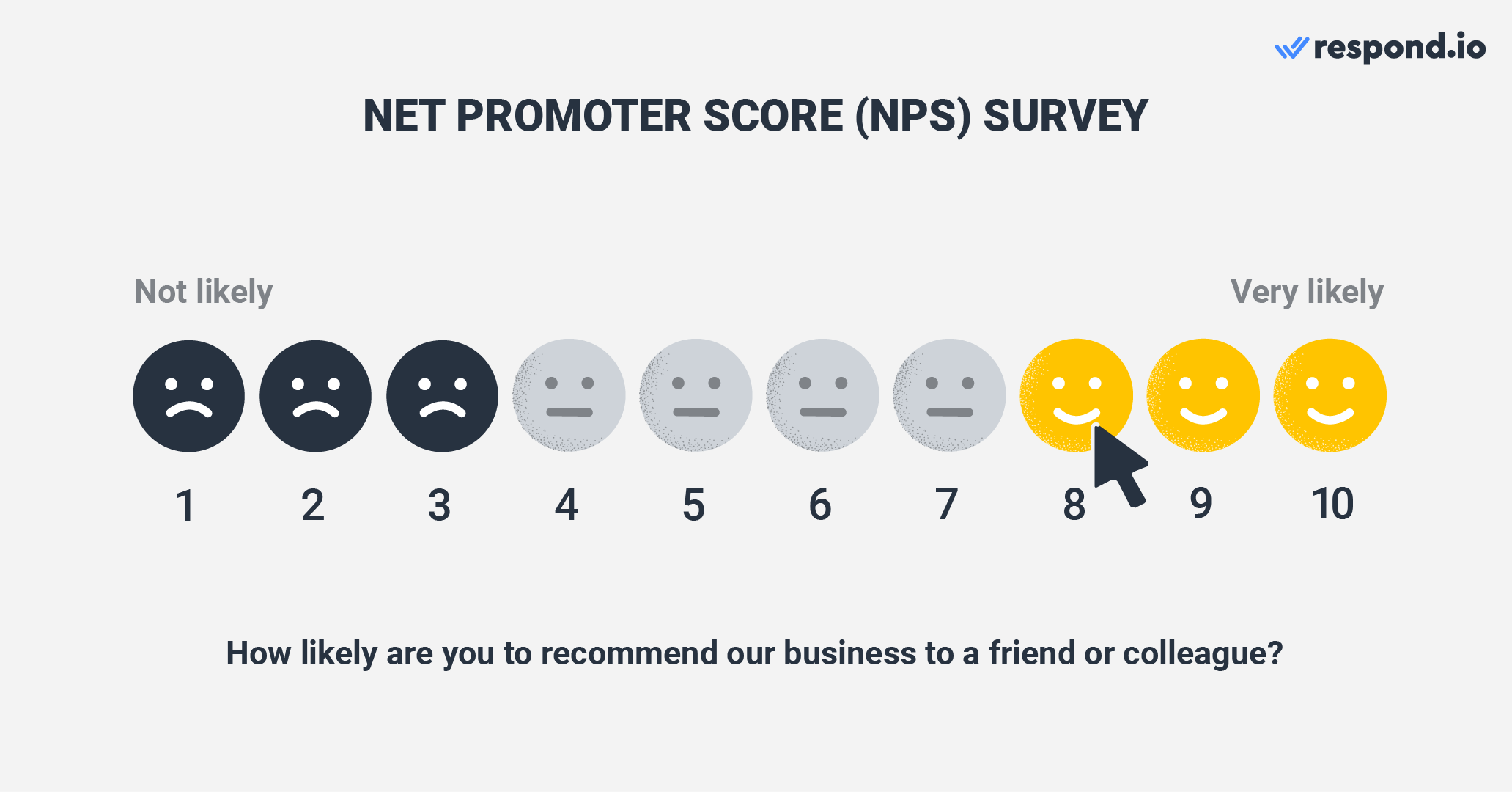
This metric focuses on building a good customer satisfaction process in the long term. By addressing the promoters and passives, businesses can create long-lasting relationships with their clients.
CES (Customer Effort Score) indicates the effort a customer has to exert to accomplish a certain action. For instance, a purchase or cancellation.
CES questions could look like this: How much effort did it take to solve your issue today? Customers typically choose a number from a numerical scale, though some surveys use colored buttons or emojis to indicate customer satisfaction.
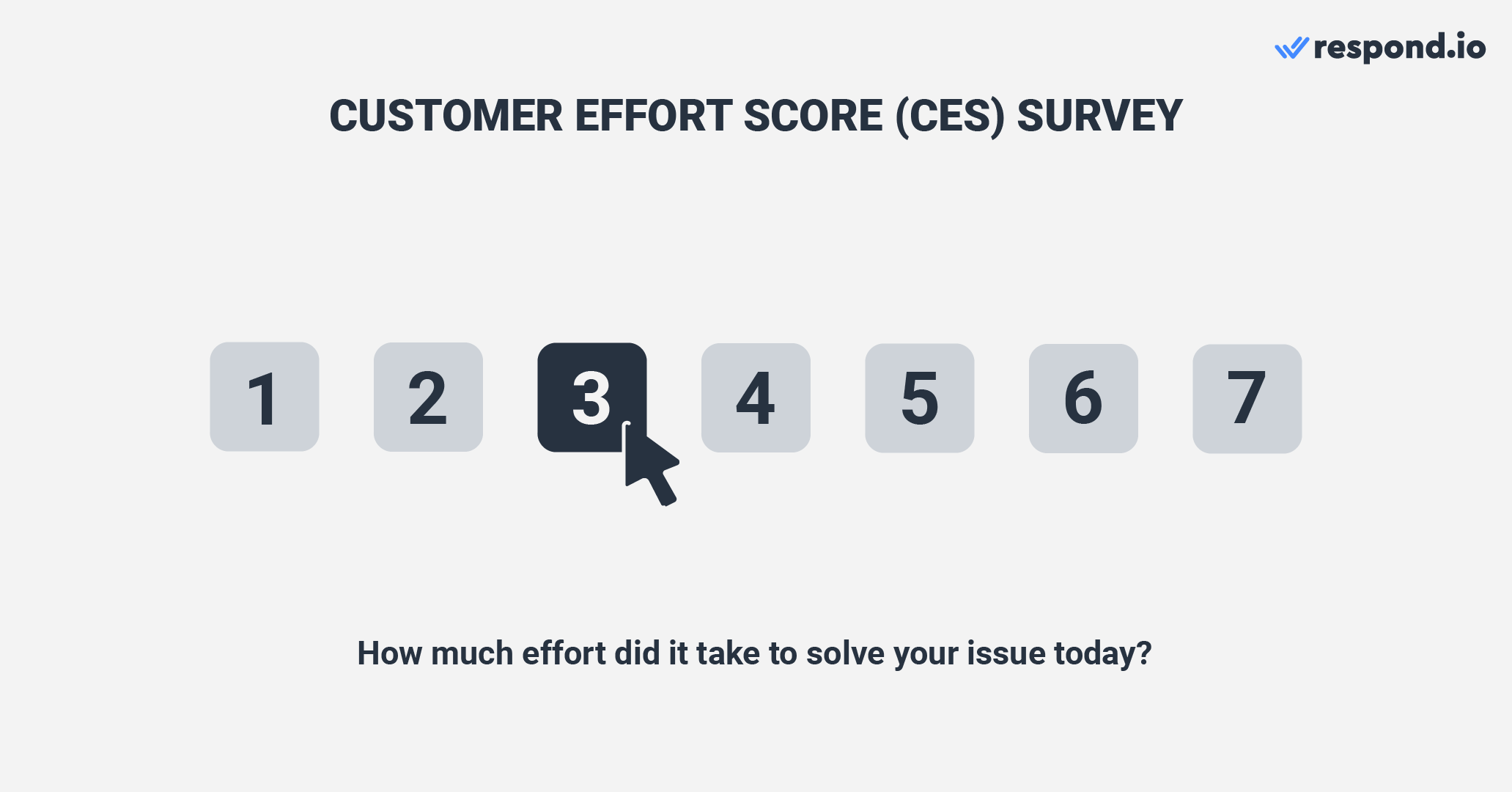
This metric is a good indicator of repeat customers and the likelihood of customer referrals. At the same time, it can reveal certain areas where the customer experience is not optimal. Similar to NPS, CES is a long-term value metric.
Lastly, there is the customer satisfaction score (CSAT). This is the most popular customer satisfaction metric, and that is why we have a whole section dedicated section to it. Keep reading to find out more.
Customer Satisfaction Score (CSAT)
In the previous section, we saw how NPS and CES surveys are useful metrics to measure long-term value. Now let’s see what the CSAT score is and how it differs from the other two metrics.
What is CSAT Score?
Unlike CES and NPS, a CSAT score measures the degree of satisfaction a customer experiences after a specific interaction with a company. Thus, companies use CSAT surveys to analyze the experience at different steps of the customer satisfaction process.
For example, CSAT is a popular metric used by support teams to determine how effective their problem-solving is.

CSAT surveys ask questions along the lines of How satisfied are you with this experience? Of all the CSAT rating systems, the most popular ones use stars, emojis, or a numeric scale. In some cases, the survey has two or more questions.
Benefits of CSAT Surveys
Because numeric values are often used, CSAT survey data is easy to work with. When a specific interaction is getting a low customer satisfaction score, the company can target the issue and find ways to improve the customer experience.
CSAT surveys are easy to answer, and it usually takes only one click. This encourages people to take them. For that reason, CSAT surveys get high response rates.
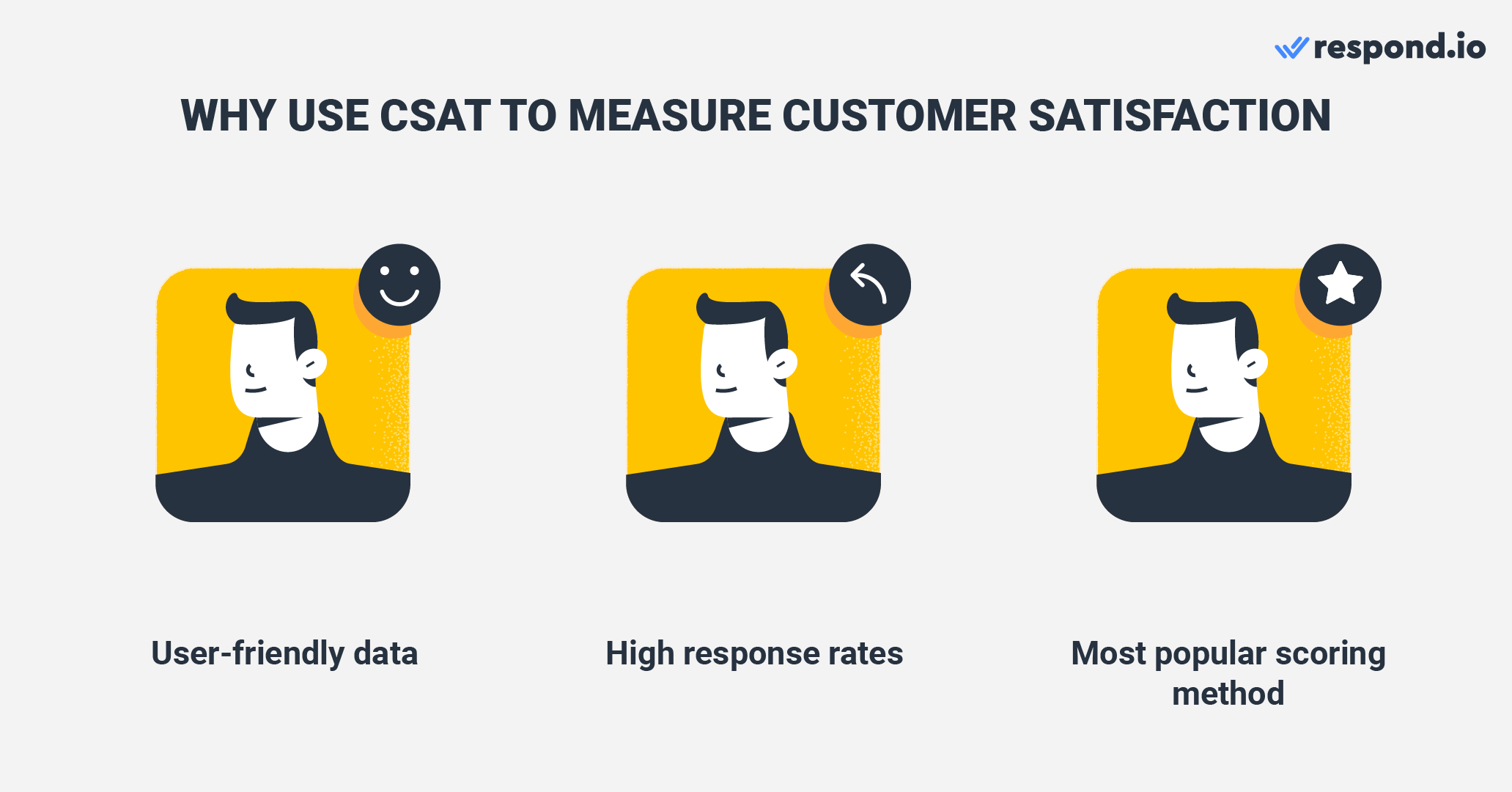
Since this is the most popular scoring method, companies often share their customer satisfaction score on their websites to demonstrate to visitors that they have an excellent customer satisfaction process.
These scores can be used as benchmarks by other companies that also use CSAT surveys to improve their own score. In the following section, we’ll explain how to calculate the CSAT score of a company.
How To Calculate CSAT Score
To calculate the customer satisfaction score, your company will first need to establish a benchmark for a good score. Then, divide the number of answers that meet or surpass that benchmark by the total number of answers submitted.

What is a good CSAT score? In general, having a CSAT score of 75% or more is considered good. But this depends on the industry and the company’s own goals.
We’ve covered both CSAT surveys and scores. In the next section, we’ll show you how to create your own CSAT survey using Workflows on respond.io. If you are not familiar with Workflows yet, we suggest you start here.
Turn customer conversations into business growth with respond.io. ✨
Manage calls, chats and emails in one place!
CSAT Surveys with Respond.io Workflows
With respond.io, Users can create CSAT survey Workflows that are triggered when a conversation with a Contact closes. Plus, choosing a Conversation Closed Trigger allows Users to implement Trigger Variables.
In short, Trigger Variables belong to the Workflow Variables category. They only exist during the Workflow session. Find the full list of available Trigger variables for the Conversation Closed Trigger here.
This type of variable allows for endless possibilities. But in the context of CSAT surveys, we suggest using Trigger Variables when sending CSAT data to a CRM using an HTTP Request Step.
Now, using the Conversation Closed Trigger has a little downside. Contacts who have several conversations in a short period of time will be sent the same survey repeatedly. This could negatively affect the customer satisfaction process.

For CSAT purposes, we generally recommend using a manual Trigger like Shortcut. This allows Users to manually send a CSAT survey by clicking on the Shortcut button in the Messages Module. Once you've chosen your preferred Trigger, be it Conversation Closed or Shortcut, it's time to create the survey in Workflows.
Creating a Client Satisfaction Survey with the Ask a Question Step
To start a survey, you’ll need an Ask a Question Step right after the Trigger. As mentioned, the most common CSAT survey question is: How satisfied are you with this experience? Type your question in the Question Text field.
The Ask a Question Step offers several Question Types to choose from. But for this purpose, you’ll want to choose Rating. The Rating Question Type is designed perfectly for this use case and allows Contacts to pick a rating between 1 and 5 stars.

The answers collected in this Step will be used in subsequent Steps. This means that they need to be saved as variables. Enable Save Response As Variable and give the variable a name. For example, rating.
The survey part is complete. But if answers are not saved, you won’t be able to calculate the customer satisfaction score. You can either save the answers to Google Sheets or to your data warehouse. We’ll look at the Google Sheets method first.
Saving the Answers to Google Sheets
To save the survey answers to Google Sheets, select the Add Google Sheets Row Step. Then, click on the Connected Google Sheet button and select the Google Sheet to save your answers.
In the Column Mapping field, name the columns with text, variables, or Google Sheets data. Remember the variable we named $rating before? Don’t forget to include it in one of the columns. Otherwise, your CSAT ratings won’t appear on the Google Sheet later.
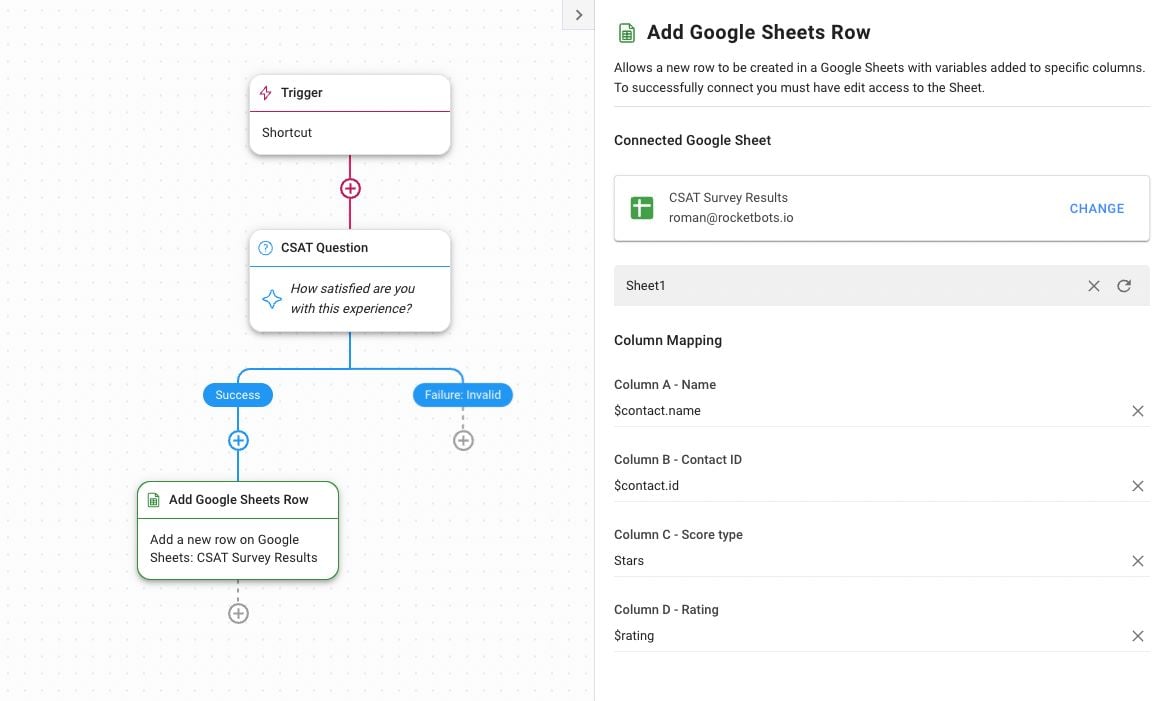
When the Workflow is triggered, the values defined in the Column Mapping field will be added to the selected Google Sheet and displayed in a new row at the bottom of the table.
Some companies work with CRMs such as Zendesk, Salesforce, or Hubspot, and prefer to have their answers saved there. We've got them covered too. Let’s see how this works in our last section.
Saving the Answers to a CRM or Data Warehouse
To save the answers to a CRM or data warehouse, we’ll need to create a webhook between its API and respond.io. This can be done by adding an HTTP Request Step after the Ask a Question Step.
To fill in the Method, URL, Body, and Headers correctly, consult the API documentation of the third-party CRM or data warehouse you are using to store CSAT data.
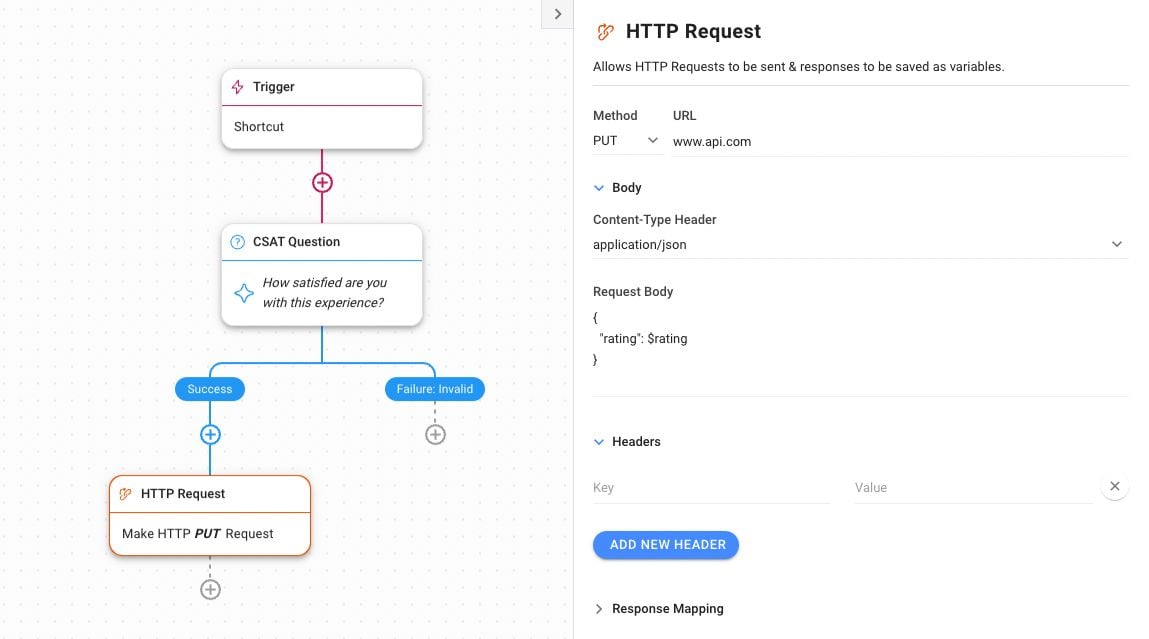
Lastly, remember to include the variable saved in the Ask a Question Step (which we previously named rating) in the Request Body field. This variable holds the survey answers that you want to transfer to your software of choice.

As you can see, respond.io makes the customer satisfaction process easy. But the possibilities don’t end there. Do you want to market, sell and support with the leading messaging platform? Sign up for a respond.io account now!
Turn customer conversations into business growth with respond.io. ✨
Manage calls, chats and emails in one place!
Further Reading
Did you find this article useful? If so, here are some other quick reads that might interest you:






































 Electronics
Electronics Fashion & Apparel
Fashion & Apparel Furniture
Furniture Jewelry and Watches
Jewelry and Watches
 Afterschool Activities
Afterschool Activities Sport & Fitness
Sport & Fitness
 Beauty Center
Beauty Center Dental Clinic
Dental Clinic Medical Clinic
Medical Clinic
 Home Cleaning & Maid Services
Home Cleaning & Maid Services Photography & Videography
Photography & Videography
 Car Dealership
Car Dealership
 Travel Agency & Tour Operator
Travel Agency & Tour Operator




